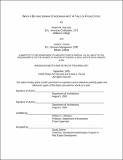| dc.contributor.advisor | William C. Wheaton. | en_US |
| dc.contributor.author | DeLaney, Robert M. (Robert Michael) | en_US |
| dc.contributor.author | Pizzuti, Linda K | en_US |
| dc.contributor.other | Massachusetts Institute of Technology. Dept. of Architecture. | en_US |
| dc.date.accessioned | 2006-06-20T12:55:47Z | |
| dc.date.available | 2006-06-20T12:55:47Z | |
| dc.date.copyright | 2005 | en_US |
| dc.date.issued | 2005 | en_US |
| dc.identifier.uri | http://hdl.handle.net/1721.1/33200 | |
| dc.description | Thesis (S.M.)--Massachusetts Institute of Technology, Dept. of Architecture, 2005. | en_US |
| dc.description | This electronic version was submitted by the student author. The certified thesis is available in the Institute Archives and Special Collections. | en_US |
| dc.description | Includes bibliographical references. | en_US |
| dc.description.abstract | This thesis is an analysis of the current trend in urban condominium and loft sales in the United States. It focuses specifically on the question of whom, demographically speaking, is buying the incredible influx of new urban residential products that has come onto the market since 2000. There is only anecdotal evidence gathered to date, where some claim that it is the empty-nesters abandoning the suburbs for the convenience of city life. However, there has not been the corresponding drop in suburban population levels or house sale levels to corroborate that hypothesis. Other market participants claim that the sales are primarily to investors, who are either renting or riding appreciation expectations to resell. If that is true, then there are considerable market implications for the future. Others project that it is an urban pied-a-terre trend; however the 2000 census only identifies 3% of the whole housing stock as seasonal, recreational, or second homes. This thesis pools and analyzes recent historical data in four urban downtowns: Atlanta, Boston, Chicago, and San Diego to determine what is happening in each city and to try to discover a national trend. It utilizes raw mortgage origination data, assessor's data, and surveys and interviews with developers and brokers in each of the four designated cities. | en_US |
| dc.description.abstract | (cont.) In addition to demographic profiles of buyers, this study determines whether these are second homes, speculative purchases, or complete relocations from outside the city. Ultimately, what can be concluded from this analysis is that a much larger segment of demand for urban condos in Atlanta, Boston, Chicago and San Diego consists of second home purchasers and investors than are counted in the 2000 Census. Surveys of 7849 units indicate 66% owner occupancy, 22% second home purchase plus investors with no plan to rent and finally another 12% investors who rent out their units. Trends are similar across markets, although the Atlanta market is driven by younger buyers and San Diego has the lowest percentage of owner occupants, indicating the most speculative buying. | en_US |
| dc.description.statementofresponsibility | by Robert M. DeLaney and Linda K. Pizzuti. | en_US |
| dc.format.extent | 98 leaves | en_US |
| dc.format.extent | 1563340 bytes | |
| dc.format.extent | 1563135 bytes | |
| dc.format.mimetype | application/pdf | |
| dc.format.mimetype | application/pdf | |
| dc.language.iso | eng | en_US |
| dc.publisher | Massachusetts Institute of Technology | en_US |
| dc.rights | M.I.T. theses are protected by copyright. They may be viewed from this source for any purpose, but reproduction or distribution in any format is prohibited without written permission. See provided URL for inquiries about permission. | en_US |
| dc.rights.uri | http://dspace.mit.edu/handle/1721.1/7582 | |
| dc.subject | Architecture. | en_US |
| dc.title | Who is buying urban condominiums? : a tale of four cities | en_US |
| dc.type | Thesis | en_US |
| dc.description.degree | S.M. | en_US |
| dc.contributor.department | Massachusetts Institute of Technology. Department of Architecture | |
| dc.identifier.oclc | 66144992 | en_US |
